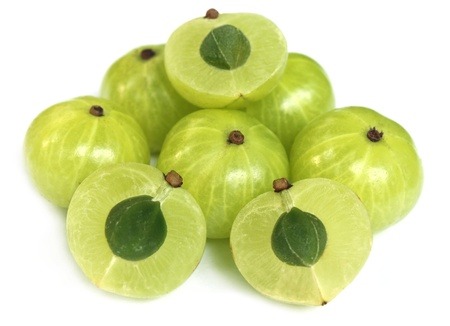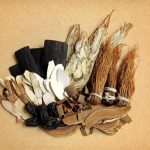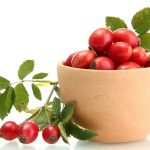
The Amla (Aonla) or Indian Gooseberry (Phyllanthus emblica L. (syn. Emblica officinalis Gaertn.) is a member of the Euphorbiaceae family. It has been a special healthy fruit in India since antiquity. The fruit is now being grown in other regions to exploit these properties such as China. It is one of the richest sources of vitamin C yielding up to 1,500 mg/100g fruit, although the range is commonly around 750 mg/100g and is ideal for processing into a variety of formats.
It is not usually eaten fresh because it is extremely tart, acidic and bitter but its juice is usually converted to a more palatable format such as a syrup or concentrate. A few reports describe using either a filtered juice or pulp (upto 30% by weight) which is prepared as a 66-70 °Brix dilutable, and which can have a shelf-life of up to 9 months if its storage is managed (Reddy and Chikkasubbanna, 2009). The syrup usually requires dilution to about 7 °Brix. Kirin Kyowa Foods Company Ltd. recently patented an application using the fruit (Atsushi & Keishi, 2013). One attractive feature is the fresh apple green colour of the syrup. Other products from Amla juice include wines which are claimed to have retained the nutritional benefits of the fruit too (Soni et al., 2009). It could be a useful means of introducing naturally sourced vitamin C into a product.
In product development terms, amla syrup has a green, fruity flavour which would not overpower other fruit juices in combination. To encourage further uptake with the public, the fruit has been candied (Sivakumar, 2013) and lends itself well to sun (solar) drying (Umayal Sundari et al., 2013). The antioxidant properties of the fruit are claimed to be improved by gamma-radiation treatment as part of a sanitization process (Khattak, 2013).
Nutritional Content
Antioxidant Content
As well as a high vitamin C content, the fruit has a very high antioxidant activity which can be ascribed to its ellagitanin/ellagic acid content (Khopde et al., 2001). One research article quotes the total phenolic content ranges from 81.5 to 121 mg gallic acid equivs. (GAE)/g with a flavonoid content from 20.3 to 38.7mg quercetin equivs./g (Liu et al., 2007) whilst a recent article cited 290 mg GAE equivs./g plant extract (Mayachiew and Devahastin, 2008).
The most interesting tannins are emblicanin A (37%), emblicanin B (33%), punigluconin (12%) and pedunculagin (14%) (Bhattacharya et al., 1999). The fruit also contains rutin, phyllembic acid, phyllembelin, emblicol and somecurcuminoids.
Mineral And Vitamin Content
Indian gooseberry contains phosphorous, iron, calcium, carotenes and vitamin B complex (Nikhil et al., 2013). Aqueous extracts have good antibacterial (Kanthimathi and Soranam, 2013) and antifungal properties (Hossain et al., 2012). One interesting observation made was that following a report on the antimicrobial properties of Amla against Staphylococcus aureus, extracts of which could be worked into edible films and packaging to extend shelf-life (Mayachiew and Devahastin, 2008).
When prepared however as a syrup or concentrate, there is a tendency for precipitation of the acids leaving a brown sludge in the bottom of the vessel. The aroma remains to be characterized.
Synergistic Antioxidant Benefits
Ethanolic extracts of amla fruit and from the rhizomes of a another plant, galangal (Alpinia galanga) have shown significantly enhanced antioxidant activity. The effect is synergistic because each extract contributes different types of antioxidants that can effectively mop up various reactive oxygen radicals and species. There was similarity too in activity and antioxidant power with that other powerful antioxidant, quercetin which is found in many fruits and vegetables. The antioxidants in the ethanolic extracts were ellagic acid (from amla) and hydroxycinnamic derivatives which helped protect a human endothelial cell line (ECV304 cells). Here is a clear cytoprotective effect which can be more fully exploited by product developers looking to improve the functional benefits of foods, especially beverages using amla. Clearly, there is great potential here to create new nutritional antioxidants for food use (Chansriniyom et al., 2018).
Fruit: Dried & Processed
The fruit itself is quite short-lived, turning brown and unpalatable within a week of being picked and so is best processed rapidly. It can be stored chilled though up to 85-90 % humidity for 8 weeks. Drying has often been the most effective method although storage of the whole fruit in saline solutions is also useful with the intention of retaining as much of the vitamin C content as possible (Varma and Gupta, 2004). Other formats include slices (Alam et al., 2010), a supari, shreds (Sagar and Kumar, 2006), flakes and powders (Vijayanand et al., 2007). A jam with upto 50% pulp and 70 g/100 g sugar has also been prepared. Sensory optimisation showed that a 45% pulp and 70 g/100g sugar with 1% acidity was ideal (Reddy and Chikkasubbanna, 2009). Similar organoleptic studies have been conducted with Amla fruit in a mixed pickle (Reddy and Chikkasubbanna, 2009). When preparing flakes and shreds the fruit is first blanched in hot water or treated with sodium or potassium metabisulphite before drying further. This reduces polyphenolic oxidase browning and microbial spoilage (Prajapati et al., 2009).
The dried fruits are used in India as part of a traditional regimen in the treatment of a number of intestinal disorders such as chronic dysentery and diarrhea, diabetes, dyspepsia, lung infections, anaemia and jaundice (Kirtikar and Basu, 1993). There are some excellent reviews on the fruit and its uses within Ayurvedic medicine (Khan, 2009; Krishnaveni and Mirunalini, 2010). A recent report described its use in treating Helicobacter pylori infection and by implication stomach ulcers (Mehrotra et al., 2011).
Products
Please not this page contains links to our affiliate marketing partners. Please read our affiliate disclosure.
1st revision – 20th August 2013
2nd revision – 22nd September 2018 – addition of information on antioxidant activity.
References
Alam M.S., Amarjit, S., Sawhney, B.K. (2010) Response surface optimization of osmotic dehydration process for aonla slices. J Food Sci Technol. 47(1) pp. 47–54
Bhattacharya, A., Chatterjee, A., Ghosal, S. Bhattacharya, S.K. (1999) Antioxidant Activity Of Active Tannoid Principles Of Emblica officinalis (Amla). Indian J. Exp. Biol. 37 (7) pp. 676-686
Chansriniyom, C., Bunwatcharaphansakun, P., Eaknai, W., Nalinratana, N., Ratanawong, A., Khongkow, M., & Luechapudiporn, R. (2018). A synergistic combination of Phyllanthus emblica and Alpinia galanga against H 2 O 2-induced oxidative stress and lipid peroxidation in human ECV304 cells. Journal of Functional Foods, 43, pp. 44-54 https://doi.org/10.1016/j.jff.2018.01.016
Jain, S.K. & Khurdiya, D.S. (2004). Vitamin C enrichment of fruit juice based ready-to-serve beverages through blending of Indian gooseberry (Emblica officinalis Gaertn.) juice. Plant Foods for Human Nutrition, 59 pp. 63–66.
Khan, K.H. (2009) Roles Of Emblica Officinalis in Medicine – A Review. Botany Research Int. 2(4) pp. 218-228
Khopde, S.M., Indira, P.K., Mohan, H. (2001). Characterizing the antioxidant activity of amla (Phyllanthus emblica) extract. Curr. Sci., 81: 185-190.
Kirtikar, K.R., Basu, B.D. (1993) Phylanthus emblica In: Indian Medicinal Plants, 2nd edn. Lalit Mohan Basu Pub, Calcutta, p 2220
Krishnaveni, M., Mirunalini, S. (2010). Therapeutic potential of Phyllanthus emblica (amla): the ayurvedic wonder. J. Basic Clin. Physiol. Pharmacol., 21 pp. 93-105.
Liu, X., Zhao, M., Wang, J., Yang, B., Jiang, Y. (2008). Antioxidant activity of methalonic extract of emblica fruit (Phyllanthus emblica L.) from six regions in China. J. Food Compos. Anal. 21 pp. 219-228.
Mayachiew, P., Devahastin, S. (2008) Antimicrobial and antioxidant activities of Indian gooseberry and galangal extracts. LWT – Food Science and Technology, 41(7) pp. 1153 -1159 (Article)
Mehrotra, S., Jamwal, R., Shyam, R., Meena, D.K., Mishra, K., Patra, R., De, R., Mukhopadhyay, A., Srivastava, A.K., Nandi, S.P. (2011) Anti-Helicobacter pylori and antioxidant properties of Emblica officinalis pulp extract: A potential source for therapeutic use against gastric ulcer. J. Medicinal Plants Res., 5(12), pp. 2577-2583,
Prajapati, V.K., Nema, P.K., Rathore, S.S. (2009) Effect of pretreatment and recipe on quality of solar dried aonla (Emblica officinalis Gaertn) shreds. In: Int Conference on Food security and environmental sustainability. Indian Institute of Technology, Kharagpur, December 17–19
Reddy, A.H. and Chikkasubbanna, V. (2009) Studies On The Storage Behaviour Of Amla Syrup. Asian J. Horticulture 4 (1) pp. 5-9
_____________________________ (2009) Studies On The Storage Behaviour Of Amla Jam. Int. J. Agric. Sciences 5(1) pp. 55-59
_____________________________(2009) Quality and Organoleptic Evaluation Of Amla Pickle cv. Banarasi Karaka. Asian J. Horticulture 4(1) pp. 233-236
Sagar, V.R., Kumar, R. (2006) Preparation and storage study of ready-to eat dehydrated gooseberry (aonla) shreds. J. Food Sci Technol. 43 pp. 349–352
Soni, S.K., Bansal, N. Soni, R. (2009) Standardization of Conditions for Fermentation And Maturation of Wine From Amla (Emblica officinalis Gaertn.) Natural Product Radiance 8(4) pp. 436-444
Varma RC, Ajay Gupta (2004). Effect of pre-treatment on quality of solar dried amla. J. Food Sci. Technol., 65(3): 397-402
Vijayanand, P., Kulkarni, S.G., Reena, P., Aksha, M., Ramana, K.V.R. (2007) Effect of processing on gooseberry fruits and quality changes in dehydrated gooseberry powder during storage. J. Food Sci. Technol. 44 pp. 591–594.



We grow a lot of alma near Hyderabad, I’d like to discuss this further. I’ll e-mail you about a proposal.
Hi Sachin, We at FoodWrite have experience with developing fruit based drinks including some that used Amla as well as guava, papaya and mango. Amla makes a very attractive, vibrant green drink and retains many of the nutrititive qualities. Its full of ellagic acids for example which are strong antioxidants. It also has quite an acidic taste which is ideal for refreshment. Look forward to hearing from you.
Where can I buy these Amlas – I live in Birmingham but no-one seems to have heard of them ?
My doctor says I have hypertension which is high blood pressure to you and me. I read some comments in other articles article that I could mix 2 tsp of amla juice with one tsp of honey and ‘consume early’ in the morning. I also want to know if fresh amla fruit, when it is eaten raw as it is, is good for blood pressure, or should I still take the juice of the amla and mix it with honey?